Strategic Management and Global Expansion Report - MGMT 690
VerifiedAdded on 2022/12/18
|5
|1115
|65
Report
AI Summary
This report delves into strategic management, focusing on the balanced scorecard and its four perspectives: learning & growth, business processes, customer, and financial. It analyzes how these perspectives apply to an organization and discusses additional strategies, such as strategy mapping and product strategy, for global expansion. The report emphasizes the importance of combining multiple strategies to mitigate risks and foster growth. Furthermore, it explores Porter's Five Forces and PESTLE analysis as tools for understanding the internal and external environments, and SWOT analysis for competitive advantage. It identifies global competitors and examines cooperative strategies, competitive market profiles, and the application of the balanced scorecard within the context of an office furniture company. The report highlights the significance of resource management in global strategies and the tools used to analyze a company's revenue system.
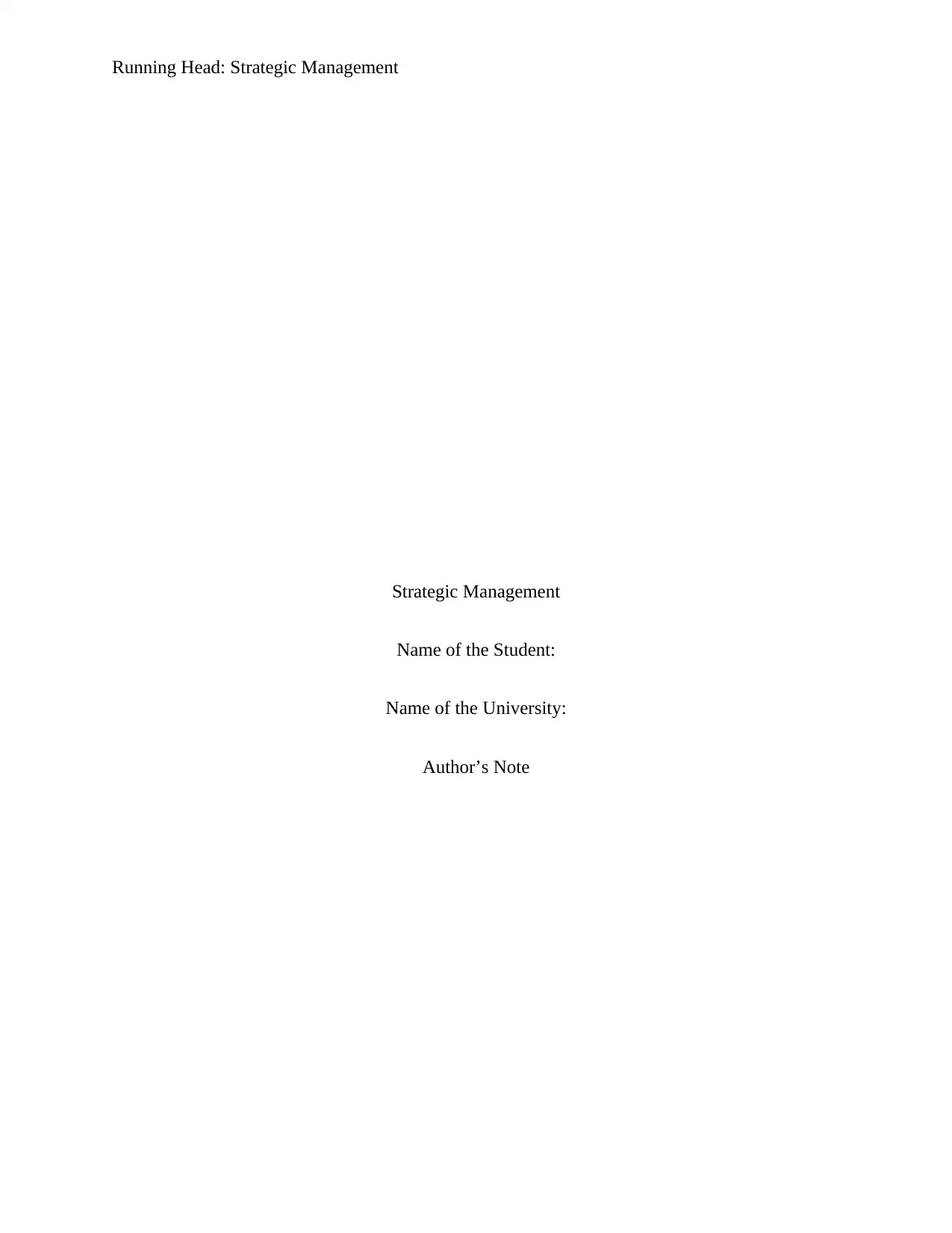
Running Head: Strategic Management
Strategic Management
Name of the Student:
Name of the University:
Author’s Note
Strategic Management
Name of the Student:
Name of the University:
Author’s Note
Paraphrase This Document
Need a fresh take? Get an instant paraphrase of this document with our AI Paraphraser
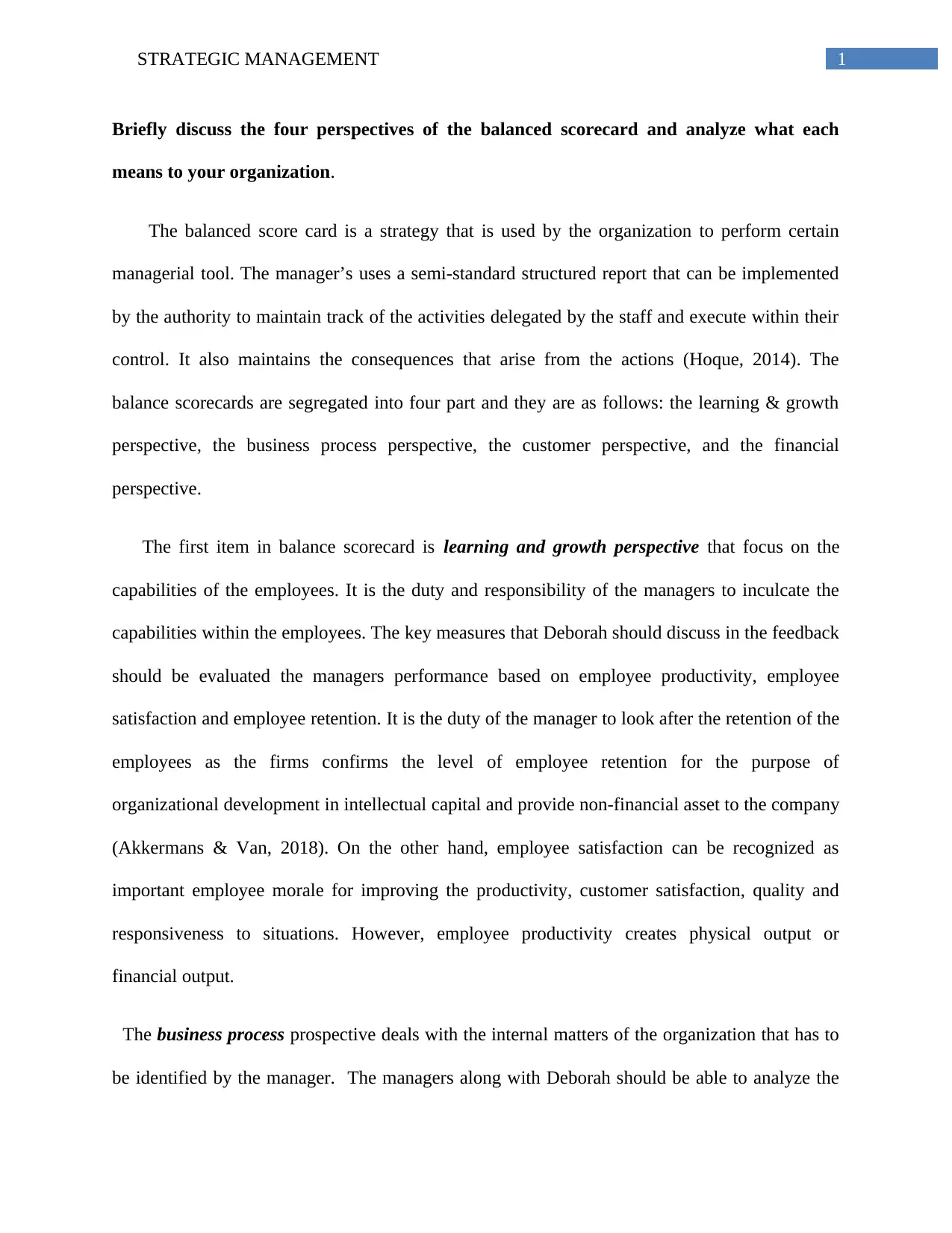
1STRATEGIC MANAGEMENT
Briefly discuss the four perspectives of the balanced scorecard and analyze what each
means to your organization.
The balanced score card is a strategy that is used by the organization to perform certain
managerial tool. The manager’s uses a semi-standard structured report that can be implemented
by the authority to maintain track of the activities delegated by the staff and execute within their
control. It also maintains the consequences that arise from the actions (Hoque, 2014). The
balance scorecards are segregated into four part and they are as follows: the learning & growth
perspective, the business process perspective, the customer perspective, and the financial
perspective.
The first item in balance scorecard is learning and growth perspective that focus on the
capabilities of the employees. It is the duty and responsibility of the managers to inculcate the
capabilities within the employees. The key measures that Deborah should discuss in the feedback
should be evaluated the managers performance based on employee productivity, employee
satisfaction and employee retention. It is the duty of the manager to look after the retention of the
employees as the firms confirms the level of employee retention for the purpose of
organizational development in intellectual capital and provide non-financial asset to the company
(Akkermans & Van, 2018). On the other hand, employee satisfaction can be recognized as
important employee morale for improving the productivity, customer satisfaction, quality and
responsiveness to situations. However, employee productivity creates physical output or
financial output.
The business process prospective deals with the internal matters of the organization that has to
be identified by the manager. The managers along with Deborah should be able to analyze the
Briefly discuss the four perspectives of the balanced scorecard and analyze what each
means to your organization.
The balanced score card is a strategy that is used by the organization to perform certain
managerial tool. The manager’s uses a semi-standard structured report that can be implemented
by the authority to maintain track of the activities delegated by the staff and execute within their
control. It also maintains the consequences that arise from the actions (Hoque, 2014). The
balance scorecards are segregated into four part and they are as follows: the learning & growth
perspective, the business process perspective, the customer perspective, and the financial
perspective.
The first item in balance scorecard is learning and growth perspective that focus on the
capabilities of the employees. It is the duty and responsibility of the managers to inculcate the
capabilities within the employees. The key measures that Deborah should discuss in the feedback
should be evaluated the managers performance based on employee productivity, employee
satisfaction and employee retention. It is the duty of the manager to look after the retention of the
employees as the firms confirms the level of employee retention for the purpose of
organizational development in intellectual capital and provide non-financial asset to the company
(Akkermans & Van, 2018). On the other hand, employee satisfaction can be recognized as
important employee morale for improving the productivity, customer satisfaction, quality and
responsiveness to situations. However, employee productivity creates physical output or
financial output.
The business process prospective deals with the internal matters of the organization that has to
be identified by the manager. The managers along with Deborah should be able to analyze the
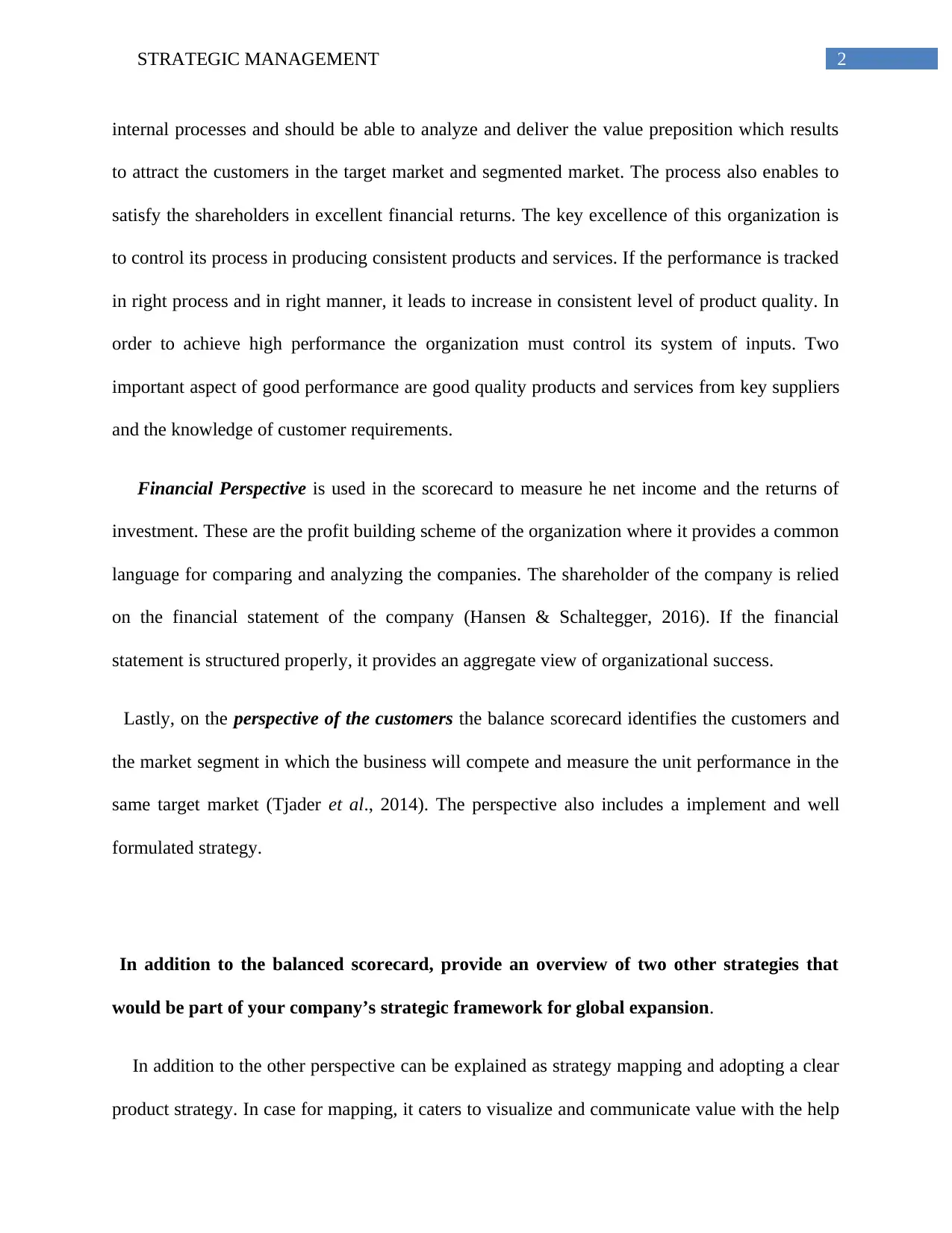
2STRATEGIC MANAGEMENT
internal processes and should be able to analyze and deliver the value preposition which results
to attract the customers in the target market and segmented market. The process also enables to
satisfy the shareholders in excellent financial returns. The key excellence of this organization is
to control its process in producing consistent products and services. If the performance is tracked
in right process and in right manner, it leads to increase in consistent level of product quality. In
order to achieve high performance the organization must control its system of inputs. Two
important aspect of good performance are good quality products and services from key suppliers
and the knowledge of customer requirements.
Financial Perspective is used in the scorecard to measure he net income and the returns of
investment. These are the profit building scheme of the organization where it provides a common
language for comparing and analyzing the companies. The shareholder of the company is relied
on the financial statement of the company (Hansen & Schaltegger, 2016). If the financial
statement is structured properly, it provides an aggregate view of organizational success.
Lastly, on the perspective of the customers the balance scorecard identifies the customers and
the market segment in which the business will compete and measure the unit performance in the
same target market (Tjader et al., 2014). The perspective also includes a implement and well
formulated strategy.
In addition to the balanced scorecard, provide an overview of two other strategies that
would be part of your company’s strategic framework for global expansion.
In addition to the other perspective can be explained as strategy mapping and adopting a clear
product strategy. In case for mapping, it caters to visualize and communicate value with the help
internal processes and should be able to analyze and deliver the value preposition which results
to attract the customers in the target market and segmented market. The process also enables to
satisfy the shareholders in excellent financial returns. The key excellence of this organization is
to control its process in producing consistent products and services. If the performance is tracked
in right process and in right manner, it leads to increase in consistent level of product quality. In
order to achieve high performance the organization must control its system of inputs. Two
important aspect of good performance are good quality products and services from key suppliers
and the knowledge of customer requirements.
Financial Perspective is used in the scorecard to measure he net income and the returns of
investment. These are the profit building scheme of the organization where it provides a common
language for comparing and analyzing the companies. The shareholder of the company is relied
on the financial statement of the company (Hansen & Schaltegger, 2016). If the financial
statement is structured properly, it provides an aggregate view of organizational success.
Lastly, on the perspective of the customers the balance scorecard identifies the customers and
the market segment in which the business will compete and measure the unit performance in the
same target market (Tjader et al., 2014). The perspective also includes a implement and well
formulated strategy.
In addition to the balanced scorecard, provide an overview of two other strategies that
would be part of your company’s strategic framework for global expansion.
In addition to the other perspective can be explained as strategy mapping and adopting a clear
product strategy. In case for mapping, it caters to visualize and communicate value with the help
⊘ This is a preview!⊘
Do you want full access?
Subscribe today to unlock all pages.

Trusted by 1+ million students worldwide
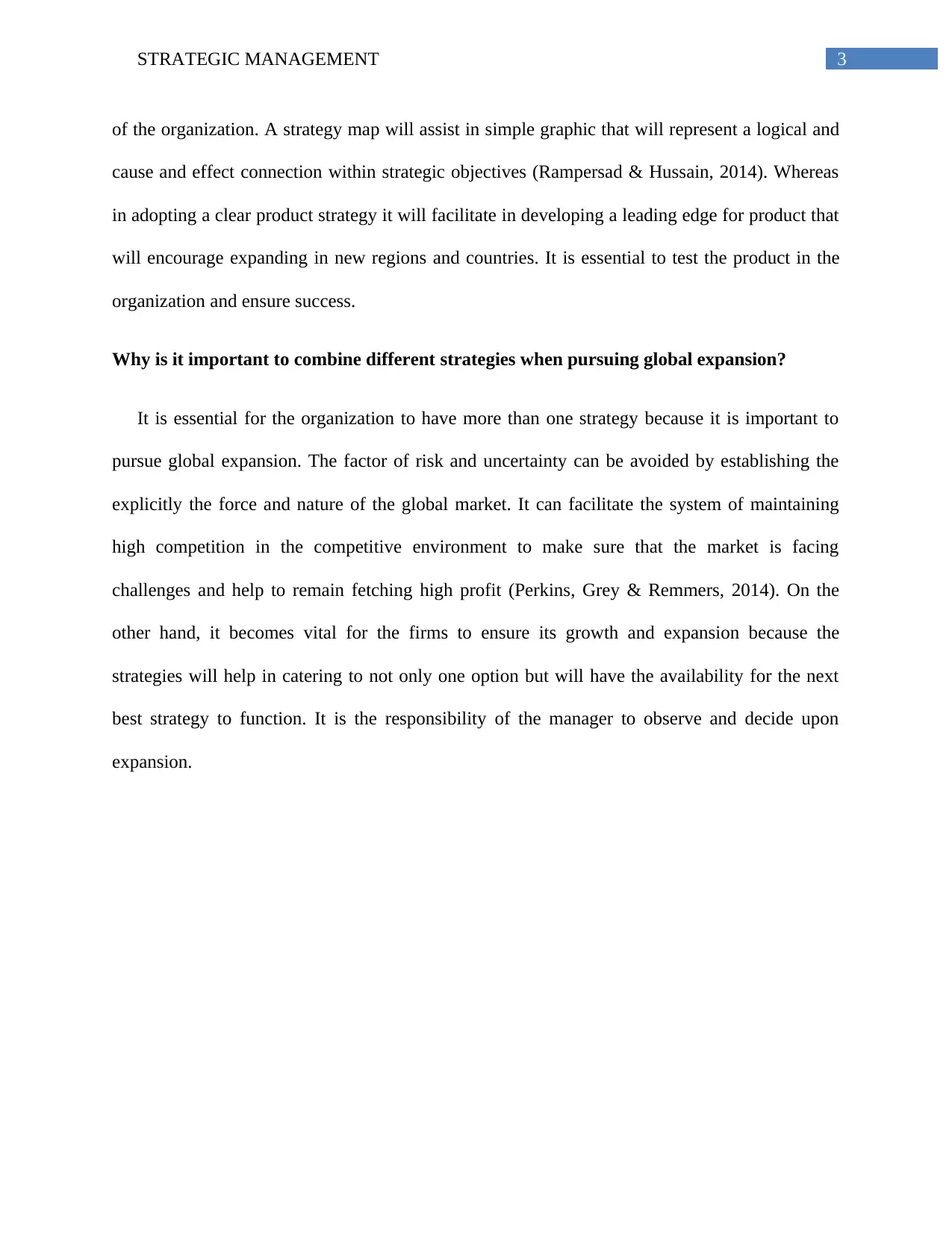
3STRATEGIC MANAGEMENT
of the organization. A strategy map will assist in simple graphic that will represent a logical and
cause and effect connection within strategic objectives (Rampersad & Hussain, 2014). Whereas
in adopting a clear product strategy it will facilitate in developing a leading edge for product that
will encourage expanding in new regions and countries. It is essential to test the product in the
organization and ensure success.
Why is it important to combine different strategies when pursuing global expansion?
It is essential for the organization to have more than one strategy because it is important to
pursue global expansion. The factor of risk and uncertainty can be avoided by establishing the
explicitly the force and nature of the global market. It can facilitate the system of maintaining
high competition in the competitive environment to make sure that the market is facing
challenges and help to remain fetching high profit (Perkins, Grey & Remmers, 2014). On the
other hand, it becomes vital for the firms to ensure its growth and expansion because the
strategies will help in catering to not only one option but will have the availability for the next
best strategy to function. It is the responsibility of the manager to observe and decide upon
expansion.
of the organization. A strategy map will assist in simple graphic that will represent a logical and
cause and effect connection within strategic objectives (Rampersad & Hussain, 2014). Whereas
in adopting a clear product strategy it will facilitate in developing a leading edge for product that
will encourage expanding in new regions and countries. It is essential to test the product in the
organization and ensure success.
Why is it important to combine different strategies when pursuing global expansion?
It is essential for the organization to have more than one strategy because it is important to
pursue global expansion. The factor of risk and uncertainty can be avoided by establishing the
explicitly the force and nature of the global market. It can facilitate the system of maintaining
high competition in the competitive environment to make sure that the market is facing
challenges and help to remain fetching high profit (Perkins, Grey & Remmers, 2014). On the
other hand, it becomes vital for the firms to ensure its growth and expansion because the
strategies will help in catering to not only one option but will have the availability for the next
best strategy to function. It is the responsibility of the manager to observe and decide upon
expansion.
Paraphrase This Document
Need a fresh take? Get an instant paraphrase of this document with our AI Paraphraser
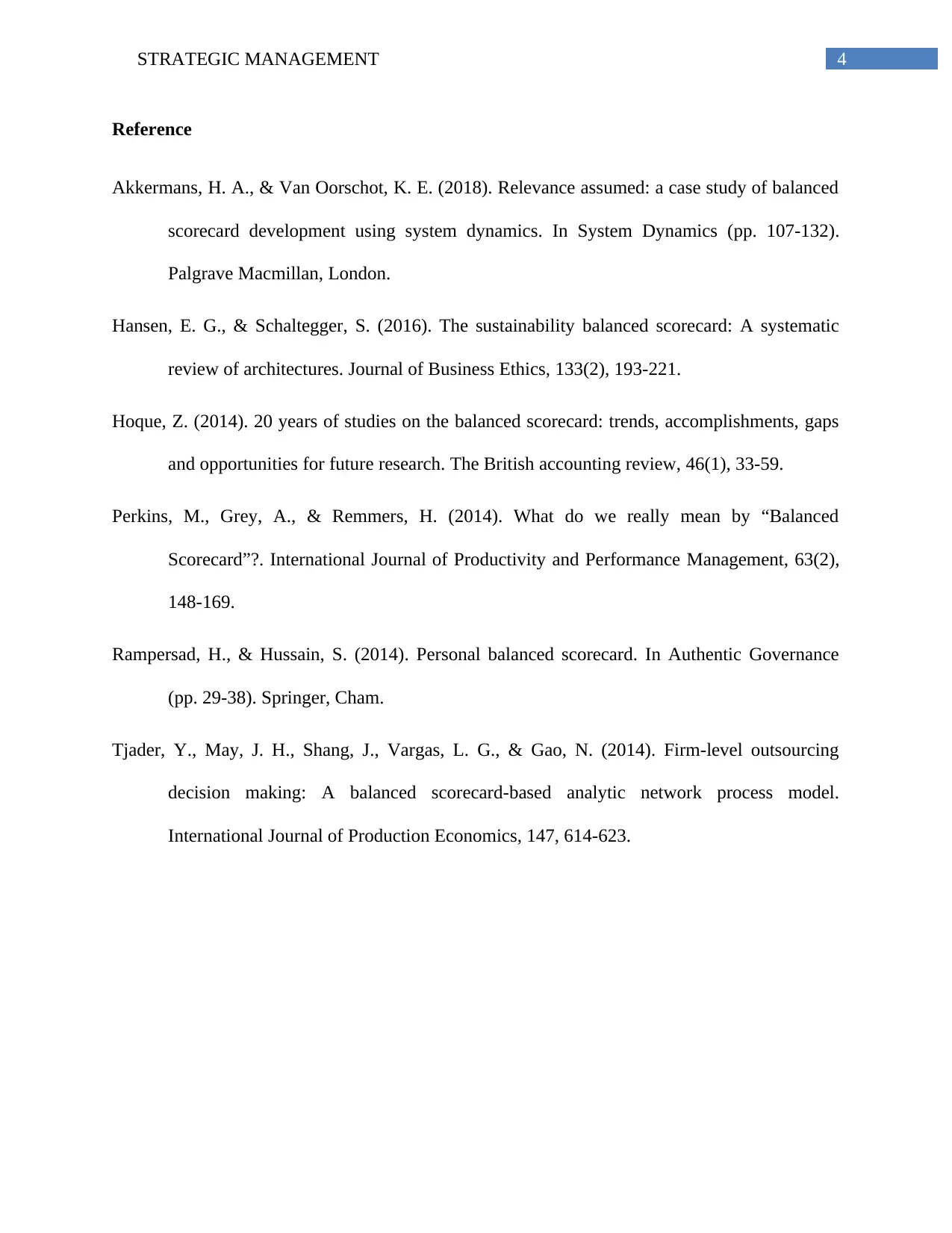
4STRATEGIC MANAGEMENT
Reference
Akkermans, H. A., & Van Oorschot, K. E. (2018). Relevance assumed: a case study of balanced
scorecard development using system dynamics. In System Dynamics (pp. 107-132).
Palgrave Macmillan, London.
Hansen, E. G., & Schaltegger, S. (2016). The sustainability balanced scorecard: A systematic
review of architectures. Journal of Business Ethics, 133(2), 193-221.
Hoque, Z. (2014). 20 years of studies on the balanced scorecard: trends, accomplishments, gaps
and opportunities for future research. The British accounting review, 46(1), 33-59.
Perkins, M., Grey, A., & Remmers, H. (2014). What do we really mean by “Balanced
Scorecard”?. International Journal of Productivity and Performance Management, 63(2),
148-169.
Rampersad, H., & Hussain, S. (2014). Personal balanced scorecard. In Authentic Governance
(pp. 29-38). Springer, Cham.
Tjader, Y., May, J. H., Shang, J., Vargas, L. G., & Gao, N. (2014). Firm-level outsourcing
decision making: A balanced scorecard-based analytic network process model.
International Journal of Production Economics, 147, 614-623.
Reference
Akkermans, H. A., & Van Oorschot, K. E. (2018). Relevance assumed: a case study of balanced
scorecard development using system dynamics. In System Dynamics (pp. 107-132).
Palgrave Macmillan, London.
Hansen, E. G., & Schaltegger, S. (2016). The sustainability balanced scorecard: A systematic
review of architectures. Journal of Business Ethics, 133(2), 193-221.
Hoque, Z. (2014). 20 years of studies on the balanced scorecard: trends, accomplishments, gaps
and opportunities for future research. The British accounting review, 46(1), 33-59.
Perkins, M., Grey, A., & Remmers, H. (2014). What do we really mean by “Balanced
Scorecard”?. International Journal of Productivity and Performance Management, 63(2),
148-169.
Rampersad, H., & Hussain, S. (2014). Personal balanced scorecard. In Authentic Governance
(pp. 29-38). Springer, Cham.
Tjader, Y., May, J. H., Shang, J., Vargas, L. G., & Gao, N. (2014). Firm-level outsourcing
decision making: A balanced scorecard-based analytic network process model.
International Journal of Production Economics, 147, 614-623.
1 out of 5
Related Documents
Your All-in-One AI-Powered Toolkit for Academic Success.
+13062052269
info@desklib.com
Available 24*7 on WhatsApp / Email
![[object Object]](/_next/static/media/star-bottom.7253800d.svg)
Unlock your academic potential
Copyright © 2020–2025 A2Z Services. All Rights Reserved. Developed and managed by ZUCOL.




